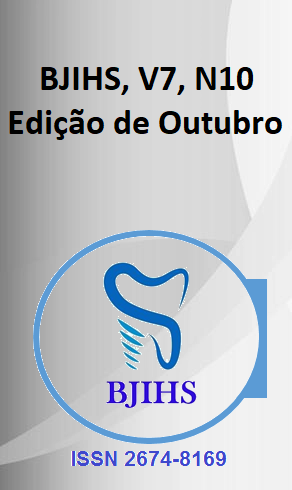Abstract
Introduction: Volumetric assessment of the upper airways has proven to be fundamental in orthodontic practice, since anatomical changes may be related to unfavorable skeletal patterns and respiratory disorders. Cone beam computed tomography (CBCT) stands out as a diagnostic tool because it offers high-resolution three-dimensional images with a lower radiation dose when compared to conventional tomography. In addition, CBCT enables more accurate linear and volumetric measurements, overcoming the limitations of traditional two-dimensional exams. Objective: Analyze the use of cone beam computed tomography in the volumetric assessment of the airway in orthodontic patients, highlighting its applicability in diagnosis and therapeutic planning. Methodology: In the bibliographic survey, the inclusion criteria were articles published in international and national journals written in Portuguese and English, as well as those published in the last 5 years, 2020 to 2025, and indexed in the databases: Pubmed and Lilacs, using literature reviews and randomized clinical studies. Articles containing clinical cases and textbooks published more than six years ago, not available in full, as well as those that deviated from the theoretical design and obtained results from animal experiments, were excluded. Conclusion: CBCT is a valuable tool in orthodontic diagnosis and monitoring of airway changes, contributing to more accurate and individualized planning. However, the need for standardized protocols and greater methodological uniformity between studies remains a challenge to be overcome.
References
AKSOZ, G.; EL, H.; PALOMO, J. M. Correlation between different boundaries used in the evaluation of the upper airway. BMC Oral Health, v. 25, n. 1, p. 19, 2025.
AL-SOMAIRI, M. A. A. et al. Correlation between the three-dimensional maxillomandibular complex parameters and pharyngeal airway dimensions in different sagittal and vertical malocclusions. Dentomaxillofacial Radiology, v. 52, n. 3, fev. 2023.
CAIADO, Grasielle Manoel et al. Orthodontists’ criteria for prescribing cone-beam computed tomography-a multi-country survey. Clinical oral investigations, v. 26, n. 2, p. 1625–1636, 2022.
CAIADO, V. et al. Increasing use of CBCT in orthodontics: marketing, digital workflow, and clinical relevance. Dental Press Journal of Orthodontics, v. 27, n. 3, p. 1-10, 2022.
COPPELSON, K. et al. Does Head and Neck Posture Affect Cone-Beam Computed Tomography Assessment of the Upper Airway? v. 81, n. 6, p. 721–733, 1 jun. 2023.
GURGEL, Marcela Lima et al. Methodological parameters for upper airway assessment by cone-beam computed tomography in adults with obstructive sleep apnea: a systematic review of the literature and meta-analysis. Sleep And Breathing, v. 27, n. 1, p. 1–30, 2023.
GURGEL, J. A. et al. Cone-beam computed tomography in airway analysis for orthodontic patients: accuracy and clinical implications. Dental Press Journal of Orthodontics, v. 28, n. 2, p. 1-12, 2023.
HELDMAIER, W.; LONIC, D.; LOEFFELBEIN, D. J. Three-Dimensional Analyses of Postoperative Effects of Surgically Assisted Rapid Palatal Expansion (SARPE) on the Soft Tissue of the Midface Region and the Upper Airway Space Using Stereophotogrammetry and Cone Beam Computed Tomography (CBCT). The American Surgeon, v. 89, n. 4, p. 553–557, 1 abr. 2023.
ISMAIL, I. N.; SUBRAMANIAM, P. K.; CHI ADAM, K. B.; GHAZALI, A. B. Application of Artificial Intelligence in Cone-Beam Computed Tomography for Airway Analysis: A Narrative Review. Diagnostics, [S.l.], v. 14, n. 17, p. 1917, 2024.
JIANG, T. et al. Alterations in upper airway morphology and respiratory function in adolescent patients with mandibular retrognathism treated with clear aligner mandibular advancement: a prospective study. BMC Oral Health, v. 25, n. 1, p. 975, 2025.
KHASAWNEH, Lina et al. Cone beam computed tomography changes upon oral appliance therapy for adult patients with obstructive sleep apnea: A non-randomized clinical trial. Medicine, v. 103, n. 40, p. e39923, 2024.
KHASAWNEH, R. R. et al. Skeletal patterns and upper airway volume: a CBCT-based analysis. Journal of Clinical Orthodontics, v. 58, n. 1, p. 34-42, 2024.
MINI, A. H. et al. Cone beam computed tomography based upper airway analysis: A comparison of three software programs. Scientific Reports, [S.l.], v. 15, n. 1, p. 1–8, 2025.
NARALAN, M. E. et al. Accuracy of upper airway volume measurements using different software products: a comparative analysis. Dento maxillo facial radiology, v. 54, n. 5, p. 350–356, jan. 2025.
POLIZZI, Alessandro; SERRA, Sara; LEONARDI, Rosalia. Use of CBCT in orthodontics: A scoping review. Journal of clinical medicine, v. 13, n. 22, 2024.
PRESA, M. R. et al. Study of the pharyngeal airway morphology with CBCT: Benefits of four premolar extraction orthodontic treatments. Nigerian Journal of Clinical Practice, v. 25, n. 12, p. 1955-1962, 2022.
RAJKUMAR, B. et al. Evaluation of Pharyngeal Airway Volume Three-Dimensionally in Various Sagittal Skeletal Patterns - Systematic Review. Indian Journal of Dental Research, v. 34, n. 2, p. 209–215, abr. 2023.
RAJKUMAR, B. et al. Three-dimensional pharyngeal airway volume assessment in various sagittal skeletal patterns – A systematic review. Indian Journal of Dental Research, v. 34, n. 2, p. 209-215, 2023.
STEEGMAN, R. et al. Cone beam computed tomography volumetric airway changes after orthognathic surgery: a systematic review. International journal of oral and maxillofacial surgery, v. 52, n. 1, p. 60–71, 2023.
SUN, J.-S. et al. Reliability assessment of craniofacial and airway measurements: a comparative study between multidetector computed tomography and cone-beam computed tomography. The Angle orthodontist, v. 95, n. 1, p. 57–77, jan. 2025.
TAKAHASHI, Masahiro et al. Three-dimensional assessment of the pharyngeal airway in Japanese preschoolers with orofacial clefts. Laryngoscope, v. 130, n. 2, p. 533–540, fev. 2020.
THI HONG THUY, P. et al. Clinical and cone-beam computed tomography outcomes of miniscrew-assisted rapid palatal expansion in the treatment of maxillary transverse deficiency: A prospective study. Medicine, v. 104, n. 38, p. e44684, 2025.

This work is licensed under a Creative Commons Attribution 4.0 International License.
Copyright (c) 2025 Isabelle Matos, Fábio Catão, Heverton Lopes, Maria Vitória Reis, Sâmara Lopes, Thairiny Macedo, Sanmyo Oliveira
